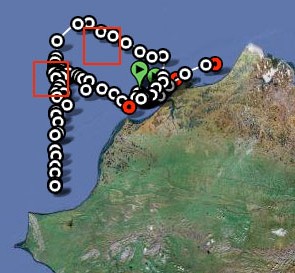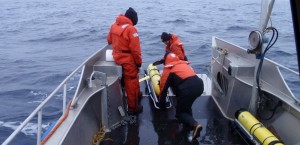 Marine scientists use gliders—one of several types of Autonomous Underwater Vehicles (AUVs)—to gather data across vast stretches of open ocean. Gliders collect precise measurements of ocean properties with a few “pilots” who work from their offices and need only go into the field for deployment and retrieval—instead of requiring many scientists, engineers and crew, plus chartered time on expensive ships.
Marine scientists use gliders—one of several types of Autonomous Underwater Vehicles (AUVs)—to gather data across vast stretches of open ocean. Gliders collect precise measurements of ocean properties with a few “pilots” who work from their offices and need only go into the field for deployment and retrieval—instead of requiring many scientists, engineers and crew, plus chartered time on expensive ships.
Gliders are especially handy in northern seas, where remote locations, harsh weather, and difficult logistics are commonplace.
Glider Sets Record
For more than nine weeks in summer 2011, an AOOS-funded glider traveled 1,000 miles in the Chukchi Sea, collecting and transmitting more than 11,000 vertical profiles of pressure, temperature, and salinity data—a new record for this type of operation in Arctic waters.
Dr. Peter Winsor at the University of Alaska Fairbanks (UAF) led the mission, part of the second year of research on the hydrographic properties of Arctic waters. This work is co-funded by the US Bureau of Ocean Energy Management, ConocoPhillips Alaska, and Shell Oil.

Screen shot of glider deployments for 2011 from the ARTLab website. Visit ARTLab to see deployment locations from 2010 and to learn more about Alaska marine remote sensing efforts.
The glider program is part of a larger remote sensing effort led by UAF’s Tom Weingartner that includes high frequency (HF) radars, drifters and moorings. Learn more about the other projects and get the latest updates from the UAF Autonomous Remote Technology Lab.
Glider data provide detailed biochemical and physical ocean data that previously have been unavailable to us … when we combine the HF radar and AUV glider data, a unique view of the ocean emerges, and with features and complexity that are changing our ideas of how this area is functioning. —Peter Winsor, UAF
The glider program is unique to the Arctic. Its success has been due to the hard work of UAF scientists Rachel Potter and Hank Statscewich along with residents of Barrow, Wainwright, and Point Lay, who provide invaluable assistance by deploying, monitoring and servicing these complex systems in challenging conditions.
Next Steps: under the ice
Because the Beaufort and Chukchi seas are covered by ice for much of the year, the team plans to expand glider operations beyond the summer months by developing AUV under-ice capabilities to further understanding of hydrography and circulation in these waters, as well as to detect and map sources of oil.


